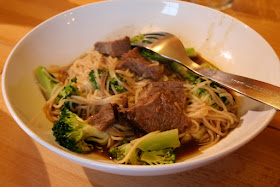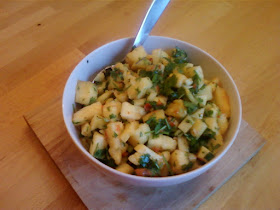I was in the butcher's today and saw what was described as "runner beef". I'm not quite sure what cut it is (should have asked) but it was cheap and looked as if it would add plenty of flavour to a soup.

When I got home, I did a bit of googling, and came up with a recipe for Taiwanese spicy beef noodle soup or niu rou mian, which I adjusted a little bit both to reflect the contents of my cupboards and in an attempt to please the delicate palates of my children.
Ingredients
vegetable oil
1 kg runner beef (or another cheap cut)
1 large leek, roughly chopped
4 cloves garlic, peeled and roughly chopped
1 tsp minced ginger
1 tsp red chile bean sauce
4 tbsps rice wine
1/2 tsp five spice powder
1 tsp allspice berries
1 tbsp dark soy sauce
3 tbsps light soy sauce
2 litres of water
plus
500g of broccoli, cut into bite-size pieces
250g of thick egg noodles noodles
Method
- Heat a few tablespoons of vegetable oil in a large pot and brown the beef thoroughly.
- Add all the remaining ingredients (except for the broccoli and noodles), bring to boil, cover and turn to minimum, and simmer gently for 2-3 hours until the meat is completely tender.
- Set lid ajar and allow to cool, then strain the broth into a large bowl. Take out the beef and set aside. Discard the other contents of the strainer (spices, leeks, garlic, ginger etc.).
- Return broth to pan, bring to boil, add broccoli and noodles and cook until tender.
- Meanwhile, remove beef from bone, trimming off the fat and any gristle, and cut into thinnish slices.
- Ladle the broth with noodles and broccoli into soup bowls, add beef slices and serve.
Apparently this is the national dish of Taiwan. To do it justice, I decided to buy the most expensive noodles in my local Chinese supermarket - a Taiwanese brand which cost somewhere between two and three times as much as the alternatives. I was not disappointed, as they were also at least two to three times as good! If you can get hold of them, these are the ones to go for:



